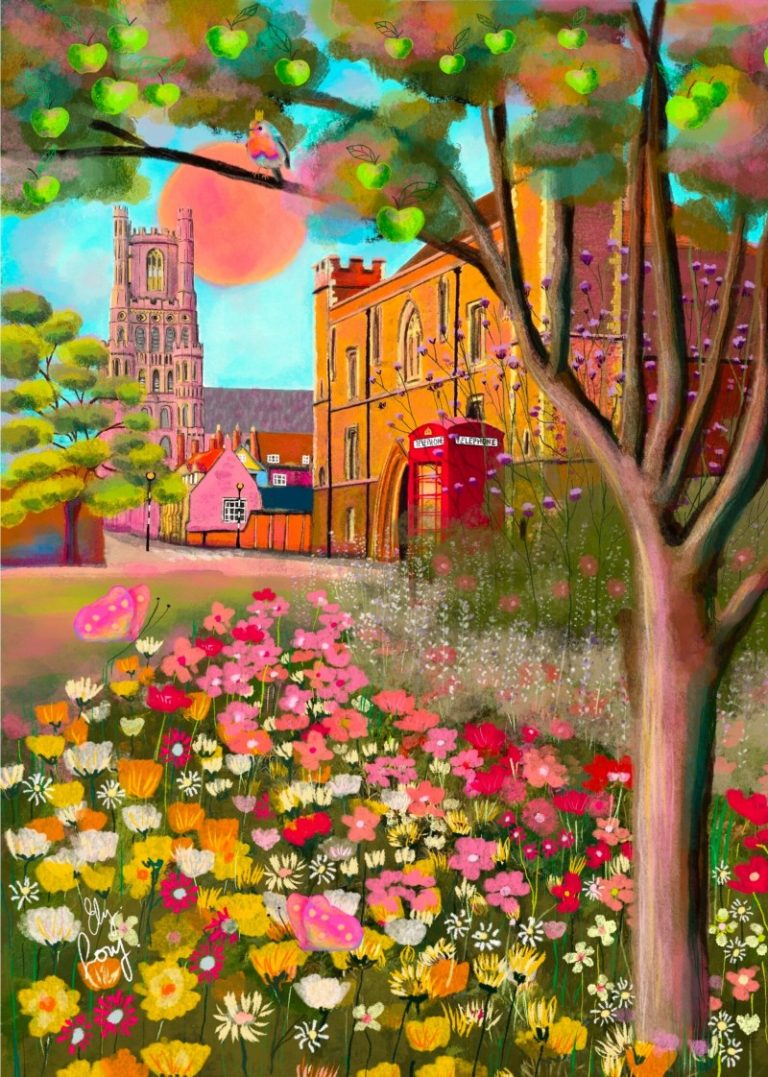
Gloucester is a welcoming city in southwest England with roots running deep into British history. People know it for its eye-catching cathedral, beautiful old streets, and the sense of community you feel as you walk around. Gloucester shares much with the tranquil Cotswolds and is building strong links with Cheltenham just up the road, making it a place where past and present meet.
The city has a knack for leaving its mark. Many remember Gloucester for being home to the Sunday School movement and the famous cathedral from Harry Potter scenes. Talk about joining up with Cheltenham is giving the area a new buzz, as these two proud places think about their future together. If you want to discover what shapes Gloucester and what makes it stand out, there’s plenty to grab your attention.
If walking in nature, always follow the Countryside Code, to keep dogs and barnyard friends safe
Gloucester Cathedral and Its Legacy
Few buildings leave such a mark on a city as Gloucester Cathedral does. Its towers can be seen from all around, giving Gloucester its signature skyline and serving as a gathering point throughout the centuries. Life here often circles back to the cathedral. Whether you spot it tucked between modern shops or lit up at sunset, it shapes the city in both quiet and bold ways.
Timeless Architecture That Inspires
Gloucester Cathedral has stood strong for over a thousand years. Locals are proud that its earliest sections were started around 1089. The building is a blend of styles, from solid Norman stonework to soaring Gothic arches. The church’s stained glass windows flood the inside in coloured light, turning normal days into something close to magical.
Walk through the cloisters and you’ll find carved stone fan vaulting above you, often copied but rarely matched. These walkways wrap around the quiet central courtyard, inviting everyone to pause. Local school children, visitors, and faithful regulars all share in this calm. It is impossible to miss just how well the old stone stands up after so many centuries.
The Birth of the Sunday School Movement
In the late 1700s, life in Gloucester looked very different. Most working-class children spent their days in factories or workshops, with little or no chance to learn to read or write. Robert Raikes, a local newspaper owner, noticed the struggles of young people growing up in poverty. Wanting to help, he started what seemed at first like a small idea: teach children to read and write on Sundays, their one day off work.
He opened the first Sunday School in 1780, close to the city’s centre. Instead of being exclusive or expensive, these classes welcomed children from every background. Volunteers taught basic literacy, helping kids unlock skills that would open up new paths for work and self-improvement.
Sunday School quickly grew, catching the attention of other towns across England. Within decades, similar schools popped up in cities near and far. People saw that if you gave children reading and writing skills, you gave them a voice.
Why Sunday School Mattered
The Sunday School movement in Gloucester went way beyond its classrooms. It laid the groundwork for reforms that shaped public education not just locally but around the world. For many children, this was the only place they encountered books and writing. For families, it offered hope that the next generation would have better choices.
Some lasting effects of Sunday School include:
- Wider access to education: Sunday Schools taught thousands who might have missed out otherwise.
- Social mixing: Children from different parts of the city learned side by side.
- Better chances in life: Literacy opened the door to jobs outside dangerous factory work.
- Community spirit: Parents, teachers, and children connected in ways that brought neighbourhoods together.
These schools didn’t just fill a gap. They showed how ordinary people can step up and make a difference for their neighbours.
The Global Ripples of a Local Idea
What started in Gloucester did not stay in Gloucester. By the early 1800s, Sunday School was copied in cities across the UK, Europe, and North America. The idea spread quickly because it worked. Teaching children to read wasn’t seen as charity; it became a basic right.
Here’s how that small start in Gloucester changed the world:
- Inspired public schools: Sunday Schools proved that working-class children could and should learn. This momentum helped drive support for free, state-run schools.
- Sparked other reform movements: The same volunteer spirit powered later causes, from temperance to votes for women.
- Changed attitudes: People began pushing for more fairness in education, work, and social life.
Gloucester’s Sunday School story is a reminder that big change often starts with small steps taken by regular people.
Community Roots in Modern Gloucester
Walk around Gloucester today and you still find echoes of those early classrooms. The city keeps its focus on helping others and draws people in for community events, charity work, and local celebrations. That old sense of pitching in for each other still runs strong.
Throughout the year, Gloucester hosts:
- Neighbourhood street parties bringing residents together
- Volunteer-run projects for everything from food banks to sports clubs
- Arts and cultural events that feel open to all, not just a select few
The same DNA that powered Sunday School now fuels community spaces, where older and newer residents share a sense of being part of something bigger. People look out for one another and often know their neighbours. When help is needed, locals step up, just as they did over two centuries ago.
Looking at Gloucester’s past and present, you see a city where education and social change come about because people truly care. That tradition began with Sunday School and keeps going, shaping and strengthening the city’s sense of community year after year.
Gateway to the Cotswolds and Cheltenham
Set on the edge of the Cotswolds, Gloucester stands as the open door to some of England’s best countryside and invites visitors in with a local warmth that’s difficult to ignore. The city’s position not only shapes the daily lives of those who live and work here but also links it closely with Cheltenham, a short drive away.
This crossroads of city and country, old and new, helps make Gloucester a unique spot. Over the past few years, the idea of joining forces with Cheltenham into a ‘super city’ has sparked debate and curiosity, drawing out opinions from every corner of the community.
The Merger: Gloucester and Cheltenham as a Super City
The idea of Gloucester merging with Cheltenham has picked up steam in local discussions, and it’s easy to see why people on both sides are looking at what could come next. Gloucester and Cheltenham sit just a few miles apart, each with its own history, feel, and loyal residents. Bringing them together could mean changes for work, travel, business, and even the small details of day-to-day living.
Some people in the community support the plan, pointing to practical reasons for joining up:
- Bigger economy: Together, the two cities could attract more jobs and businesses, offering more options for workers and helping shops and restaurants to grow.
- Shared transport improvements: A super city could push for better road, rail, and bus links, making it easier to get around without a car. Quicker journeys between the city centres would help commuters and shoppers alike.
- Joined-up services: Things like health care, schools, and rubbish collection could be better managed on a larger scale, possibly leading to improved services or better value for money.
Supporters also believe a combined city could have a stronger voice when drawing attention and funding from local and national government. By acting as one, the new super city might pull in big events, boost the arts scene, and gain a bigger say in regional decisions.
Not everyone feels the same pull towards a merger, though. Many Gloucester and Cheltenham residents have deep roots in their towns and love their individual identities.
Gloucester holds tight to its working heritage and ship canal, while Cheltenham is famous for Regency buildings. Some people worry that a merger could put this character at risk or lead to local pride fading away.
Common concerns about the plan usually centre on:
- Loss of identity: Worries over Gloucester or Cheltenham losing what makes them unique
- Uneven investment: Fears that one area could gain more attention and funding than the other
- Day-to-day confusion: Uncertainty about how council tax, schools, or rubbish collection would work if rules changed
Local forums, newspapers, and online groups regularly feature heated (but usually friendly) arguments on the topic. Some see the growth as a chance for a fresh start, while others want to keep things just as they are.
At the heart of the debate, day-to-day life sits quietly in the balance. A merger could mean more jobs, improved travel, and a better shopping and nightlife scene. But it could also bring teething problems, like changes to local rules or a shake-up of familiar routines. Many families, business owners, and workers are simply waiting to see clear details before making up their minds.
Still, the idea that these two proud neighbours could join as a gateway to Gloucestershire and the Cotswolds keeps people talking. Whatever happens next, Gloucester’s close tie with Cheltenham shapes its future, keeping it open to fresh possibilities while holding tight to the things that have always made both cities special.
Conclusion
Gloucester blends old charm with a friendly, forward-thinking spirit. You see echoes of its rich history in the cathedral and the Sunday School movement, but you also feel fresh energy in its growing communities and lively debates about the city’s future. The mix of tradition and new ideas makes Gloucester a city that’s easy to connect with and hard to forget.
With its doors open to the Cotswolds and a close link to Cheltenham, Gloucester has a strong sense of place that keeps it welcoming and real. Whether you love history, want a taste of true community life, or just fancy a walk through streets full of character, Gloucester could easily become your new favourite English city.






